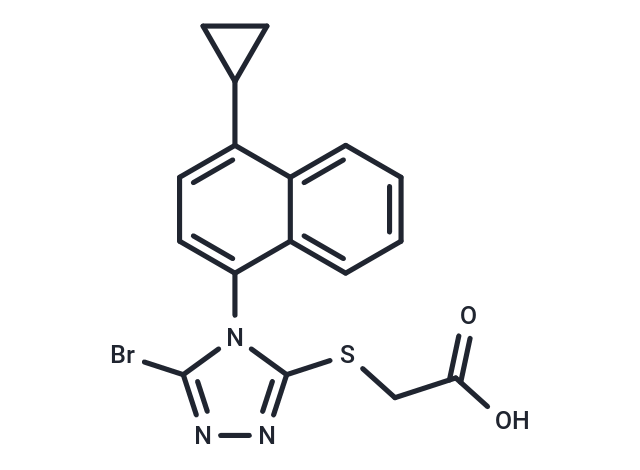Shopping Cart
- Remove All
 Your shopping cart is currently empty
Your shopping cart is currently empty

Lesinurad (RDEA594) is a selective inhibitor of uric acid reabsorption which is used in combination with other agents in the therapy of gout. Lesinurad has had a limited clinical use but has not been associated with serum enzyme elevations during therapy or with instances of clinically apparent liver injury.

| Pack Size | Price | Availability | Quantity |
|---|---|---|---|
| 10 mg | $39 | In Stock | |
| 25 mg | $77 | In Stock | |
| 50 mg | $135 | In Stock | |
| 100 mg | $219 | In Stock | |
| 200 mg | $327 | In Stock | |
| 500 mg | $548 | In Stock | |
| 1 mL x 10 mM (in DMSO) | $30 | In Stock |
| Description | Lesinurad (RDEA594) is a selective inhibitor of uric acid reabsorption which is used in combination with other agents in the therapy of gout. Lesinurad has had a limited clinical use but has not been associated with serum enzyme elevations during therapy or with instances of clinically apparent liver injury. |
| Targets&IC50 | OAT1:0.85 µM (Km), OAT3:2 µM (Km) |
| In vitro | Lesinurad inhibits the uric acid transport activity of human URAT1 (hURAT1) at a 20-fold higher potency compared to rat URAT1 (rURAT1), with IC50's of 3.36 and 74.84 μM, respectively. Lesinurad inhibits hURAT1 through an interaction that involves a critical residue, Phe365[1]. |
| In vivo | Lesinurad (RDEA594) exhibits better pharmacokinetics than its pro-drug RDEA806. The 100 mg dose of Lesinurad exhibits a pharmacological effect in the range of that produced by 300 mg to 800 mg single doses of RDEA806[2]. |
| Cell Research | Lesinurad is solubilized in DMSO and stored, and then diluted with appropriate media before use[1]. Validated oocytes, HEK293, MDCK-II, Caco-2 or MDCK-MDR1 cell systems are used to study the interaction of Lesinurad with membrane transporters localized to the kidney (OAT1, OAT3, OCT2, MATE1, and MATE2K) or liver (P-gp, BCRP, OATP1B1, OATP1B3, and OCT1). Xenopus laevis oocytes are injected with OAT1 or OAT3 cRNA or control (water) while HEK293 cells are stably transfected with MATE1, MATE2K, or vector and MDCK-II cells with hOATP1B1, hOATP1B3, hOCT1, hOCT2, or vector. The MDCKII cell line is stably transfected with the human MDR1 gene to create a P-gp cell line. The interaction of Lesinurad with BCRP relied on the endogenous expression in Caco-2 cells. All cells are cultured with growth medium according to standard methodology. In order to determine whether Lesinurad is a substrate for a transporter, cells are incubated with [14C]-labeled Lesinurad at various concentrations and the amount of Lesinurad taken up by the cells determined by subtracting the uptake in vector cells from that in the transfected cells. The uptake of a [3H]-labeled known substrate of the transporter served as the positive control. Inhibition of a transporter by Lesinurad is determined by incubating cells with a fixed concentration of [3H]-labeled known substrate and various concentrations of unlabeled Lesinurad. Inhibition by a known inhibitor of each transporter served as the positive control. Cells are incubated for the appropriate amount of time. All reactions are terminated by the addition of ice-cold medium. The cells are then rinsed with medium and lysed[1]. |
| Alias | RDEA594 |
| Molecular Weight | 404.28 |
| Formula | C17H14BrN3O2S |
| Cas No. | 878672-00-5 |
| Smiles | OC(=O)CSc1nnc(Br)n1-c1ccc(C2CC2)c2ccccc12 |
| Relative Density. | 1.72 g/cm3 (Predicted) |
| Storage | Powder: -20°C for 3 years | In solvent: -80°C for 1 year | Shipping with blue ice. | |||||||||||||||||||||||||||||||||||
| Solubility Information | DMSO: 50 mg/mL (123.68 mM), Sonication is recommended. Ethanol: 50 mg/mL (123.68 mM), Sonication is recommended. H2O: < 1 mg/mL (insoluble or slightly soluble) | |||||||||||||||||||||||||||||||||||
Solution Preparation Table | ||||||||||||||||||||||||||||||||||||
DMSO/Ethanol
| ||||||||||||||||||||||||||||||||||||

Copyright © 2015-2025 TargetMol Chemicals Inc. All Rights Reserved.